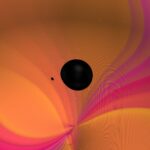
Virgo and LIGO spot a mystery object merging with a black hole

Visualization of GW190814, Credit: N. Fischer, S. Ossokine, H. Pfeiffer, A. Buonanno (Max Planck Institute for Gravitational Physics), Simulating eXtreme Spacetimes (SXS) Collaboration.
When the most massive stars die, they collapse under their own gravity and leave behind black holes; when stars that are a bit less massive die, they explode in supernovas and leave behind dense, dead remnants of stars called neutron stars. For decades, astronomers have been puzzled by a gap that lies between neutron stars and black holes: the heaviest known neutron star is no more than 2.5 solar masses, and the lightest known black hole is about 5 solar masses. Now, scientists from LIGO and Virgo have announced the discovery of an object of 2.6 solar masses, placing it firmly in the mass gap. About 800 million years ago, this object merged with a black hole of 23 solar masses and, in so doing, emitted an intense gravitational wave. Since the observation of this wave alone, which was detected on Earth in August 2019, does not allow us to distinguish whether the compact object is a black hole or a neutron star, its precise nature remains a mystery.
For more details, read the full press release and see the GW190814 detection page.
Further information:
- LIGO Lab news item on GW190814
- Virgo Collaboration news item on GW190814
- EGO news item on GW190814
- Publication: GW190814: Gravitational Waves from the Coalescence of a 23 Solar Mass Black Hole with a 2.6 Solar Mass Compact Object (published in The Astrophysical Journal Letters).



